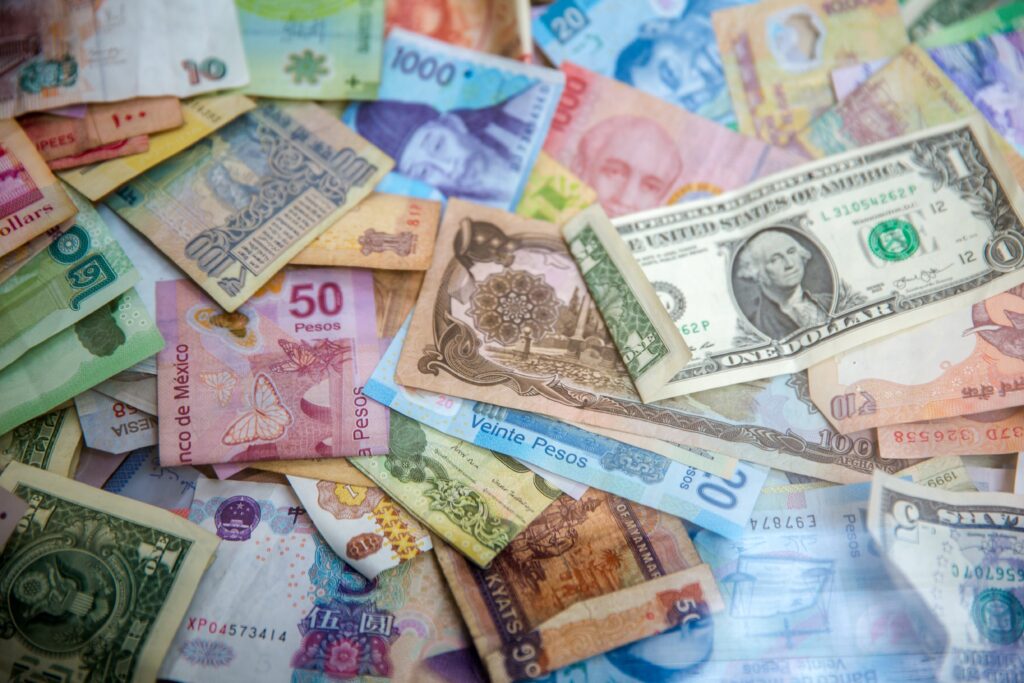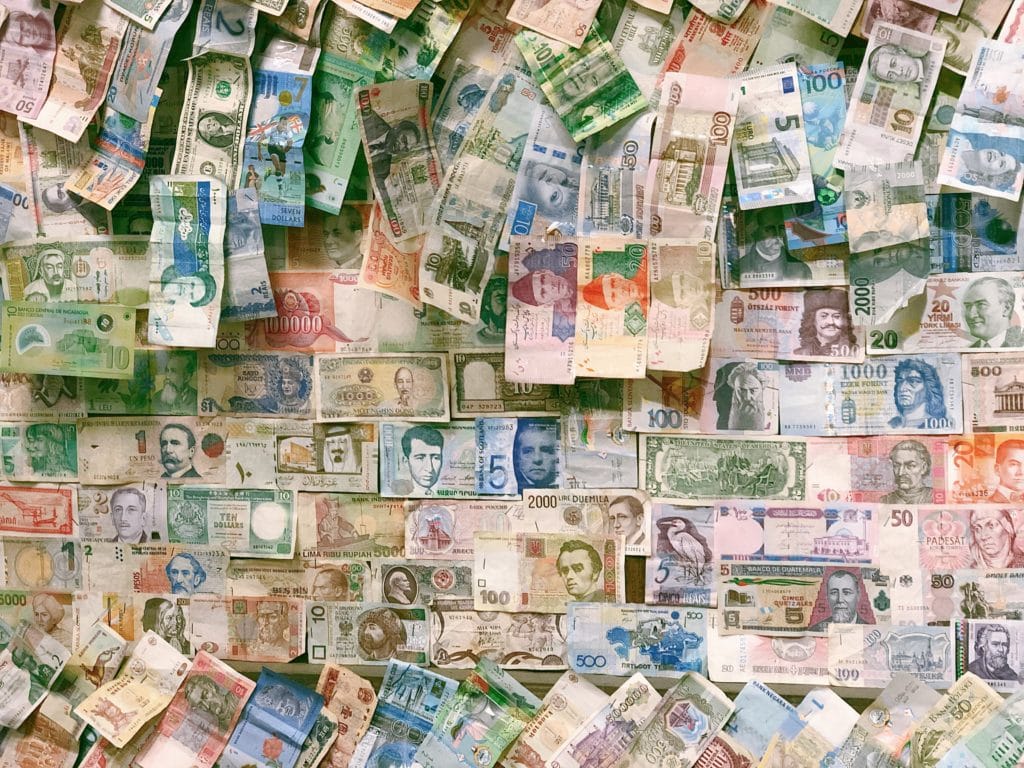Currencies of the World: How Well Do You Know Your Money?
  

What do you know about the money in your pocket? What about the bills and coins of other countries—or digital forms of money, for that matter? Have you ever wondered which of the world’s currencies are the strongest, rarest, or most traded?
As money transfer experts, we’re fascinated by the stories of the world’s money. That’s why we created this guide to the currencies of the world. Plus, you’ll learn about currency exchange and how to easily send money across borders.
From the riyal in Saudi Arabia to the Swedish króna, from the euro to the peso, here’s everything you need to know about currencies of the world.
What are world currencies?
Let’s start with the essentials. Currency is a term that refers to different types of money used in various countries. Currencies of the world can vary from country to country, so different money is used in China and Switzerland. The value of currency also varies; one unit of money in El Salvador won’t always be equal to one in India, for example.
Historically, currency could take the form of tea, shells, or even cheese, but these days, physical currency is most often found in the form of a coin or banknote.
Banknotes and coins are produced in a mint, using a secure procedure to reduce the possibility of theft or counterfeiting. Each country has its own treasury to produce its money, using its own images, symbols, and other conventions.
Currencies of the world also have unique codes established by the International Organization for Standardization (ISO) for easy abbreviation.
Currency names vary, but there are overlaps. For instance, the Australian dollar (AUD) and the dollar used in Canada (CDN) have different values, even though they are both “dollars.” You can’t use Canadian dollars in Australia, and vice-versa. The same goes for the New Zealand dollar (NZD).
How are currencies traded and transferred?
World currencies are exchanged daily, especially for business and political purposes. In fact, almost 50% of U.S. currency is held outside the United States.
The market exchange rate dictates the value of each currency compared to another. The exchange rate can change from day to day, and it’s based on a variety of economic and political factors that the issuing government can’t always control.
International money transfer companies can help you send funds from one country to another, usually for a small fee.
How many currencies are there in the world?
There are around 180 types of currency in the world used in 195 different nations as recognized by the United Nations.
The oldest currency of the world that’s still being used is the Great British pound (GBP). Though new bills have been printed and designs have improved over time, the GBP has been the currency of the United Kingdom since the 8th century.
The currency used in Russia, the Russian ruble, has changed over time but dates back to the 13th century. The Israeli shekel has been used since the 80s, but it first came into existence during the 4th century. The South Sudanese pound is the newest currency of the world and was released in July 2018.
What is the rarest currency of the world?
The rarest coins in the world are discontinued, but you may be able to find them hidden away somewhere in a treasure chest. They include:
-
The 1794 Flowing Hair Silver Dollar, which was designed by the U.S. Mint’s first Chief Engraver, Robert Scot
-
The 1787 Brasher Doubloon, originally worth about $16 Spanish dollars but now valued at over $9 million
-
The 1787 Fugio cent, designed by Benjamin Franklin and the first coin to enter circulation in the U.S.
-
The 723 Umayyad Gold Dinar, an Islamic coin from the region that’s now
Saudi Arabia
-
The 1343 Edward III Florin, a pure gold coin of which only three remain (two are in the British Museum)
Other rare currencies include historical types of money, money from countries that are hard to visit, and limited edition banknotes and coins.
One fun example is the Canadian Gold Maple Leaf coin, reportedly the largest gold coin in existence. It’s 20 inches thick and weighs in at 220 pounds. Although it was made for promotional purposes, it has a face value of $1 million CAD.
What is the strongest currency of the world?

The strongest currencies of the world are those that have the highest value compared to other currencies. The foreign exchange rate determines which currency is the strongest at any given time. Although the U.S. dollar is among the most widely used currencies of the world, it isn’t necessarily the strongest.
At the time of this writing, these are the top 7 currencies of the world:
-
Kuwaiti dinar
(
KWD
)
-
Bahrain
dinar (BHD)
-
Omani
rial
(OMR)
-
Jordanian dinar
(JOD)
-
British pound
(
GBP
)
-
Cayman Islands dollar (KYD)
-
Euro (
EUR
)
Which currencies are backed by gold?
Despite gold’s popularity as an investment, gold has not been used to back the value of a currency since the 1970s. The “gold standard,” which refers to a system where cash is worth a specific amount of gold, is not currently used by any government.
Most nations now use fiat currency, which refers to money backed by the central bank of a government, instead of gold, silver, or other commodities.
The world’s major currencies, including the U.S. dollar, are fiat currencies.
The six most-traded currencies
Many currencies of the world are traded by businesses, individuals, and even nations. As of this writing, the top six most popular currencies for trading are:
-
U.S. dollar
(
USD
)
-
Euro (
EUR
)
-
Japanese yen
(
JPY
)
-
Great
British pound sterling
(
GBP
)
-
Australian dollar
(
AUD
)
-
Canadian dollar
(CDN)
In some cases, foreign currencies are used by other countries. For example, Chinese exports may be priced in USD instead of Renminbi (RMB), which translates to “the people’s currency.” The U.S. dollar is the most commonly used and traded currency, even if it isn’t technically the strongest currency of the world.
What are the three types of currencies?
There are three types of money or currency of the world:
Mục Lục
Commodity money
Commodity money is goods exchanged for services or money. The goods refer to gold, silver, or other commodities the country may supply to others.
Fiat money
Fiat money is money that’s backed by a government but not by gold or other physical commodities. This is why a country’s economy and political situations often affect the value of its currency.
Fiduciary money
Fiduciary money is the liquid money—including cash, checks, banknotes, or bank drafts—that’s in circulation within a country.
What about cryptocurrency?
The main difference between fiat money and cryptocurrency is that fiat money derives its value because it’s backed by a government, while cryptocurrency is not.
Cryptocurrency is a digital currency that derives value from its native blockchain. The systems that govern its distribution and regulation are very different from fiat money and highly complex, which is one of the reasons it’s easy to run into cryptocurrency scams.
Exchange rates explained
An exchange rate refers to the value of one currency in relation to another—for example, how many Mexican pesos are equal to one U.S. dollar.
You can also think of an exchange rate as showing how much of one currency can be bought by one unit of another. These rates are important for people making international money transfers or planning overseas travel.
Your trip may be more or less expensive in your home currency, depending on how strong it is compared to the currency of your destination.
World currency guide
Facts about African money
The R100 banknote of South Africa—known as the South African Rand—features an image of a prison to commemorate Nelson Mandela, who was imprisoned on Robben Island for 18 years before becoming president in 1994.
For more interesting facts about currencies in Africa, take a look at these guides:
Facts about Asian money
Did you know that the strongest currency of the world is in Asia? One Kuwaiti dinar is worth more than three U.S. dollars.
Other strong currencies from Asia include the Japanese yen and the Singapore, Hong Kong, and Brunei dollars.
For more interesting facts about Asian currencies, check out these currency guides:
Facts about European money
The euro (EUR) was introduced into most European Union (EU) countries starting in 1999, including Spain, Portugal, Cyprus, and the Netherlands. Before that, most European nations had their own currencies.
The euro has been beneficial for businesses in the EU. It’s also convenient for travelers to Europe since it’s used in almost every EU nation. If you’re traveling from Belgium to Denmark via Germany, you can simply use the same money in each country.
Not all countries in the region use the euro, or at least not yet. Other European currencies include:
Turkey and Norway aren’t part of the EU, so they might never change their currencies over to the euro. Countries that are part of the EU, such as Poland, are obligated to adopt the euro eventually.
Facts about Latin American money
Some Latin countries, like Ecuador, use the U.S. dollar as their official currency. Others, like the Dominican Republic and Brazil, have their own currency, but you may find that individuals or businesses there accept U.S. dollars too.
Here are more interesting facts about the currency of Latin American countries:
How to send money around the world

If you have loved ones overseas, then you know how important it is to be able to send them money when they need it. Cashier’s checks and bank drafts may come with hefty service fees, and it can take weeks for the money to arrive at its destination.
Electronic money transfers make it easier and more affordable to send money to your family and friends around the world. You can transfer money directly from your bank account to a foreign bank account without any hassle.
You’ll still need to pay the exchange fees and transfer fees, but the funds can be sent right away, and you can track the speed of the transfer within the app.
Remitly makes international money transfers faster, easier, more transparent, and more affordable. Our reliable and easy-to-use mobile app is trusted by over 5 million people around the world. Download our app to learn more.
Further reading















![Toni Kroos là ai? [ sự thật về tiểu sử đầy đủ Toni Kroos ]](https://evbn.org/wp-content/uploads/New-Project-6635-1671934592.jpg)


